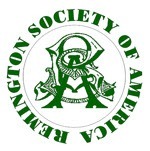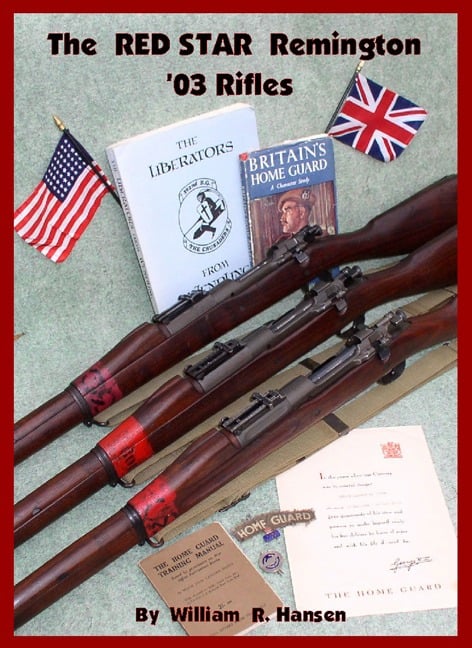
The continuing saga of 200 “Lend-Lease” rifles perserved for posterity
50-plus years ago by a World War II Army Air Corps navigator.
Forward
The July 1999 issue of the late Frank Mallory’s U.S. MARTIAL ARMS COLLECTOR
magazine introduced arms collectors to a previously little known private
cache of Model 1903 Springfield rifles manufactured by the Remington Arms
Company (RA) during World War II. Without fanfare a year or so before, five
wooden crates each containing 12 rifles dating from early 1942 suddenly
appeared on the market for sale and study in a substantially original,
as-issued condition. At the time, Mr. Mallory had
| Page 16 | 3nd Quarter 2007 |
|
already spent a goodly portion of his life churning out facts and information about all manner of U. S. martial arms. By choice, his research was principally confined to the National Archives and other certified U.S. government resources. However, among many gaps in his findings was credible evidence relating to the manufacturing character and disposition of the World War II Remington Model 1903, especially the early version proximating the 1919 Rock Island edition. Upon learning of the existence of sixty Remington M1903 rifles made under the “Lend-Lease” program for England ~Eall at one location, and ravaged only by two arduous “journeys across the pond”, Mallory not only became interested, but decided to depart from his long standing Springfield Research Service (SRS) policy to have |
 The Remington factory in Illion, New York during World War II. At this time Main Stret ran right through the facility and product had to be transported from one building to another by cross-over bridges. Remington Archives Photograph |
|
the story told in his “U.S. Martial Arms Collector” magazine. What happened thereafter is now history, including the invaluable data these rifles have subsequently provided to scholarly research. Nevertheless, significant questions about their mysterious origin have long lingered since the entire story was never fully disclosed. In the past eight years, much has changed. In 1999, the author did in fact withhold numerous details regarding origin, quantity and disposition of the rifles out of respect for the World War II Army Air Force (USAAF) officer personally responsible for having preserved them for posterity. At the time, this noble veteran was still very much alive, and placed a high value on personal privacy. But, he has now passed away… God rest his soul. For that matter, so has the venerable Frank Mallory along with the Red Star Military Museum and Sales emporium in Culver City, California from whence the rifles became known. So, while the march of time continues its relentless toll taking on mere mortals, the rifles endure. Nonetheless, Part II of the story can now be told. And yes… this author remains hopeful of still being around to compose the final Part III-conclusion before his own “return to dust.” The Rear View Mirror |
marvelous artifacts generally refer to them as such. But, their intrigue is made no less wondrous by many doubters who consider the revelation a hoax perpetrated for some kind of contrived credibility. Despite such skepticism, however, the “Red Star” Remington rifles are the real deal… as well as a profound modern day phenomenon having contributed much to the evolution of knowledge about how Remington made the last of the ’03 rifles for WWII, thus bringing the U.S. military bolt rifle era to an end. As a Remington employee after WWII, Clark Campbell wrote fine books which have unquestionably generated an enormous curiosity over the years regarding the Remington WWII story …yea, to the point of whetting the appetite of a growing lot of purest gun cranks wanting to know even more. Indeed, since the aforementioned 1999 article, collector interest has considerably intensified. Sadly, however, key manufacturing facts and record information critical to complete and accurate comprehension has been eternally lost for reasons not surprising in today’s world. It is oft the corporate reasoning of a well-run business concerned for market-share that retention of useless old paperwork is tantamount to wasting valuable space. This was the predicament of the Remington Arms Company …anxious after 5 or more years of incredibly loyal service to our nation to want to return its enterprise to pre-War profitability. Understandably, |
| Page 17 | 3rd Quarter 2007 |
|
therefore, Remington disposed of much of its Ilion, New York WWII plant records after the mandatory 10-year holding period elapsed in 1955. Now what? Indeed, for the arms collector and history buff alike, it left pursuit of future study about the past confined to an examination of remnant hardware. But, the problem persisted for no less disconcerting reasons. As most collectors of U.S. martial arms have come to learn, unless such a rifle somehow fell through the net, the post War U.S. armory/depot re-manufacturing process irreversibly compromised all primal evidence of factory originality. The objective of these programs was reconditioning rifles for the rigors of war, not preservation for either collector or armchair warrior. Thus, stock sanding, metal refinishing and the indiscriminate mixing of replacement, |
 “Red Star” Remington Model 1903 rifles removed from their wood crate “prisons.” |
surplus and spare parts became a
standard routine for rebuilding these
rifles. And while such rifles today
satisfy many collector/shooters desiring
only a representative copy, they are
loath to the purist fancier of historical
exactitude. There simply is little chance
for a classic collector-historian to know
for absolute certainty how such rifles
were originally constituted without a
hopelessly futile trip back into time.
In summary then, until the near
unmolested virtue of the “Red Star”
rifles became extant in sufficient quantity
to study and learn from, the story of the Remington Arms Company’s manufacturing odyssey at Ilion, NY during the early
1941–1942 period was largely steeped in conjectural extrapolation from remnants of what some folks irreverently consider
“parts” or “junk guns”. It still is and getting worse. Even with use of logical and reasonable inference techniques, credible
research without verifiably as-issued original examples becomes a beguiling slippery slope when trying to affirm authentic
Remington morphology…especially during the first 9 months of manufacture. Yes, other unmolested original rifles do show up
occasionally from a few thousand-salvaged “Lend-Lease” returns commercially imported for civilian purchase by international
arms merchants in the mid-1950s. Unfortunately, surviving rifles are few in number and widely dispersed.
Introduction
As revealed 8 or so years ago, “…at least 10 crates of British “Lend-Lease” Remington ‘03’s came back from England in
about 1955 and remained essentially unopened for over 40 years”. Five of the crates (holding 12 rifles each) were consigned
by the original importer/owner to “Red Star Military Museum and Sales” of Culver City, California for sale. This happened
during the 1997-99 period, with most selling rapidly as collector’s learned of their existence. As it turns out, an unaccounted for
number of additional rifles have surfaced over the years from the same owner that were either sold or given away as gifts to
friends and acquaintances, particularly in the Southern California region.
As British WWII “Lend-Lease” rifles, each “Red Star” bring-back had a red painted band around the stock wood just
behind the front sling swivel along with a black-stenciled number 30 or 300 appearing within the red band-field on the left side
of the rifle. This was a non-destructive marking required by 1940 British dated Army Council Instruction (ACI) No.1571 for any
“Class 1 Arms” not firing British Service ammunition.
| Page 18 | 3rd Quarter 2007 |
Except for various British ordnance depot markings, this was the only modification made while serving our Allies in England.
And while once viewed as an act of desecration by collectors, its presence now seems to add both historical significance
and intrinsic value. Why? Collectors eventually have come to appreciate the obviously simple fact that such markings are
likely among the only remaining evidence of an unaltered factory issued rifle anywhere in existence.
The single most unique characteristic identifying a “Red Star” ‘03 is complete absence of British export proof stamps
required for commercial sale. For reasons not entirely understood, these particular rifles were allowed to depart English soil and
shipped back to the United States sans the markings. Indeed, they might well be the only known examples of US Lend-Lease
rifles having
returned from the
UK altogether
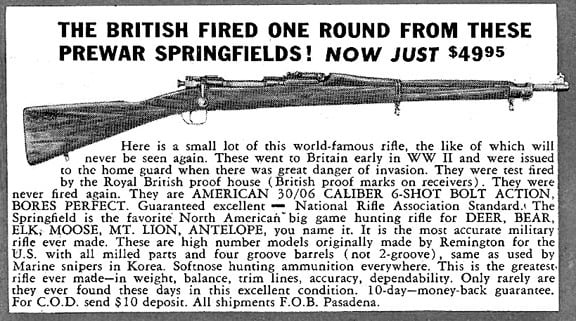
bypassing formal
British export
protocol for rifles
commercially
released into the
civilian market. The
only explanation
offered by British
military historians
engaged by this
author is the rifles
had either
“…dropped out of
the official net”, or
believed by the
Ministry of Supply
to be “…officially
transferred to
another Government”.

|
As previously stated, the individual responsible for bringing the “Red Star” Remington’s back home to the USA is now Meanwhile, Part II will focus on the man to whom all Remington ’03 |
production effort. Lastly, it presents a close-up
photographic series not a part of the 1999 article, including
one of the “Red Star” rifles as it came out of the original crate still covered with
a straw-like packing and grease.
The Man Behind The Rifles
No story about a collectible rifle can ever be entirely complete without a
glimpse of those who made it possible. To that end we pay tribute posthumously
to Lt. Col. Willard Levin, U.S. Army Air Force (USAAF). As previously
alluded, he would never consent to a personal interview for privacy reasons.
But, thanks to certain family members, friends, acquaintances and public
records; the essence of his life can be revealed.
When Captain Willard Levin made a decision after his final military
assignment to England and subsequent release from active service with the
USAAF in 1951 to arrange bringing a quantity of Lend-Lease M1903 rifles back to the United States, rifle collecting per se was
not his strong motivation. Indeed, the ’03 as a collectible had a long way to go. He was a military man and he loved competitive
An advertisement in the April 1956 issue of the American Rifleman.
Lt. Col. Willard Levin
U.S. Army Air Force
| Page 19 | 3rd Quarter 2007 |
him? Furthermore, he had an edge. He was
acquainted with many officials in the British Ministry
of Supply (MOS). Indeed, they were his personal
friends, including some in the Contracts and Sales
Branch located right there in London. But, I’m
getting ahead of myself. So, just who was Captain
Willard Levin?
Willard Levin was born on December 2, 1915 in
Columbus, Ohio to Harry & Molly Levin, both
immigrants from Russia. His father was a Tailor and
mother a housewife. He also had two sisters. After High School, he went on to Ohio State University, graduating with a Degree
in Mechanical Engineering. Then after a tour of duty with the Corp of Engineers in 1940, young Willard became enamored by
what was to become America’s eventual entry into World War II. Specifically, the Army Air Force (USAAF) and overseas duty
attracted his attention. So, he enlisted on August 1, 1941, enrolling at the newly established Army Air Force pilot training facility
in Hondo, Texas. After graduation from its now famed Navigation School in 1943, he was assigned a Consolidated B-24 “Liberator”
crew located at March AFB, California as a
navigator.
Bombardment
Wing, 2nd Bomb Division, later known as
the 2nd Air Division, Eighth Air force. From the
time the 392nd took it’s Liberators into the air in
September 1943 until its last mission some 19
months later (April 1945), Lt. Levin flew a total
of 30 missions with 2 out of the 4 operational
Bomb Squadrons stationed at Wendling, i.e. he
was attached to both the 576th and 578th
Squadrons during his tour of duty there.
Needless to say, this was a tempestuous
time in young Levin’s life. As he was to quickly learn, the prospects of enemy aircraft and flak guns were not the only enemy:
|
“…Besides the risk to life and limb, an airman had to endure from between four to eight hours—and sometimes as much as ten—in cramped conditions exposed to constant noise and vibration. Much of the time the flight was at altitudes where uncomfortable oxygen masks had to be worn and temperatures down to minus 40 degrees Fahrenheit necessitated heavy clothing to prevent frostbite. Such was the grim lot of a Liberator crew member.” |
But, with luck on his side along with introduction of the P-51 long-range fighter escort and a strong anticipation of coming
home to the girl of his dreams, he was fortunate enough to make it through this horrendous war without major incident.
Whereas, the 2nd Air Division’s casualties consisted of 1,458 lost B-24’s and 6,700 killed in action, the 392nd Bomb Group alone
| Page 20 | 3rd Quarter 2007 |
lost 184 aircraft with 1552 killed or wounded while carrying out key bombing missions over every kind of German armament
production facility one can think of across the English Channel. Indeed, when put in perspective, it is truly a stunning statistic
when one realizes at full strength, there were only about 60 Liberators flying out of Wendling at any one time. But, over the
War’s duration, that also translates on an average of the 392nd losing their entire Bomb Group over 3 times! The 392nd is probably
best known for its utter destruction of the Me-110 aircraft industries at Gotha, Germany wherein they were awarded the “…coveted
Distinguished Unit Citation (DUC) for superior bombing and leadership efforts in the “Big Week” operation” from
February 20-24, 1944.
Upon completion of his tour of duty and the end of the War, Lt. Levin went home having been awarded the Distinguished
Flying Cross; the Air Medal with Four Oak Leaf Clusters and the Air Force Commendation Medal. He also went home to marry
the love of his life…even though she didn’t know it until almost War’s end. He had met Anne Elkowitz in 1941 after enlisting as
an ROTC pilot, then attending a party thrown by her uncle the very first weekend after being stationed at Foster Field near the
town of Victoria, Texas. He was immediately attracted to her. She was a librarian at the local Victoria College. She also possessed
an inspiring enthusiasm for learning and education, furthering his intrigue. The War years following interrupted their
relationship, even though they corresponded frequently. But after his relocation to England to fight the War, things radically
changed for this aviation warrior. He not only had grown-up, but also progressively realized his strong affection towards Anne.
Being so far away from home no doubt contributed to it. He also learned while in England that Anne had moved to his home
State of Ohio. Hmm!? That got him to thinking about her motive for doing so and the possibility she felt the same way about
him. So, after his flying missions had ended and the War winding down, he finally got up enough nerve to ask her to marry him
…via a letter, no less. Much to his dismay and good pleasure, she responded almost immediately with an unequivocal …YES!
After War’s end and marriage, Anne taught elementary school. Willard went back to college while remaining in the USAAF.
Throughout their wonderful life together, they both “ …shared the same kind of passion and conviction” for education. In
1947, Capt. Levin completed his post-graduate studies at the Air Force Institute of Technology (Wright-Patterson AFB, Ohio),
and together they returned to Willard’s beloved England where he served as an Air Armament Officer through the end of his
active duty in 1951. It was on this last assignment he would meet many of the key officials within the British Ministry of
Supply (MOS) he would later do business with. Indeed, for a man who loved guns and shooting, it proved to be an opportunity
of a lifetime. Incidentally, Capt. Levin “…was a member of the Air Force Pistol Team for ten years”. He was also a coach
for the “U.S. Pistol team at the Maccabiah Games in Israel”. Willard Levin remained in the USAF as a Reserve Officer and
finally retired on October 31, 1965 as a Lt. Colonel. His other decorations and awards while serving his country consisted of:
Defense Service Medal; WWII Service Medal; WWII Victory Medal; Armed Forces Reserve Medal with Hourglass Device; Air
Force Commendation Medal; National Defense Service Medal; American Campaign Medal; European-African-Middle Eastern
Campaign Medal and the Guided Missile Insignia Medal.
In closing this segment, Lt. Col. Willard Levin and his beloved Anne spent the last half of their life in Southern California.
After retirement from the Air Force, Levin worked as a Senior Engineer for McDonnell Douglas Space Division and continued to
shoot for fun and competition. But, as with most of us in this world, their life was not without sadness or loss. A most severe
blow came upon learning of the tragic and unexpected death of their only son Arnold at age 22 in the mid-1960’s. Nevertheless,
when Levin’s life-mate Anne passed away at the turn of the millennium, it was to become his saddest day…a day from which he
never fully recovered. Lt. Col. Willard Levin died peacefully on July 14, 2006 not quite reaching his 91st birthday. He was laid to
rest near his cherished Anne at the Hillside Memorial Park in Culver City, California near Los Angeles.
Remington ‘03s Come Home
Having made the acquaintances that he did while serving out his last assignment in England, Capt. Willard Levin was
exposed to much of the British protocol for armament demobilization. He had become very good friends with many in the British
War Office, including the Ministry of Supply and various Ordnance Depots charged with disposing of an enormous volume of
surplus war material clogging up valuable warehouse space. The nation was desperately trying to complete the process of
disarming itself after the War…with the bulk of foreign weaponry acquired under the US Lend-Lease program being especially
targeted.
History has documented that much of the small arms surplus ended up at the bottom of the Atlantic Ocean and/or arranged
to be given away with permission of the U.S. War Department to other Allied countries loyal during the War effort. But, looming
on the horizon during this period was a number of war surplus contracts involving enterprising privateer small arms dealers from
the United States such as Sam Cummings of Interarms fame (Alexandria, Virginia) and Seymore Ziebert of Golden State Arms
Corporation (Pasadena, California). Levin learned first hand what was happening and the thought of somehow getting involved
more than just entered his mind. As an avid pistol shooter, he had already been able to access a number of handguns for
personal use while stationed in England, including the venerable Colt M1911, .45 Cal. automatic.
| Page 21 | 3rd Quarter 2007 |
He’d toyed with the idea for a long time, but it wasn’t until he arrived back on U.S. soil that things finally fell into place. He
and Anne had settled in Dayton, Ohio at the time. He was still exploring many options for what to do for the rest of his life.
After a series of exchanges with his UK connection, he confirmed the availability of Springfield, Model 1903 rifles of an
unknown origin, but was not given assurance a purchase transaction could be arranged. As might be expected, legal issues
involving incredible “red tape” had managed to complicate international arms sales. Indeed, in order to satisfy British legal
requirements, he was required to have a registered local agent on English soil to serve as intermediary for export purposes to the
US. In pressing the matter with his old friend F. E. Jordan, then representing the Deputy Director of Contracts for the Contracts
and Sales Branch, Ministry of Supply ( MOS – High Holborn, London ), he was finally informed by letter dated January 5, 1955
that “…the MOS has consented to sell…a quantity of M1903 Springfield rifles” to him. As it turned out that “quantity”
translated into a total of 200 rifles.
Needless, to say Levin was thrilled, but he had a concern. Having done his homework, he wanted information on the
pedigree of the rifles in question. In particular, he wanted to make sure they weren’t “…of early manufacture having serial
numbers below 802,000…,” i.e. any pre WWI single heat treat receivers of initial Springfield manufacture; and since he also
knew where the rifles were warehoused, he wrote a letter back to Jordan on January 10th asking him to contact “…Major G.J.
Athill at the Central Ordnance Depot” at Weedon to verify the serial numbers. He advised Jordan that if he got a satisfactory
answer, he would proceed with the contractual agreement as presented.
|
Note: Over a long history before being permanently closed in 1965, the Weedon depot facility served the British military in many capacities including, “Central Ordnance Depot under the direct control of the War Office”. During WWII, “Lend-Lease started the flow of American weapons of all kinds, and together with the spares for all these weapons, Weedon became an extremely busy place”. But, in the 10year period after the War from 1947 to 1957, it served primarily as “…the Small Arms Provision Branch (P6)”. It is important to realize that: “After the war huge quantities of Small Arms …were returned to Weedon and the major function of the Depot was returned stores”. Indeed, its major function was managing incredible quantities of returned stores at a time when “…inside storage became acute.” |
|
Levin got his answer eight days later. In a |
 “Red Star” Remington Model 1903 rifles still in protective grease. |
After carefully considering his options, Capt.
Levin decided to go ahead with the transaction…as
is, rifles sight unseen! Little did he know that the
rifles would neither be of Springfield or Rock Island
origin? The fact is he had absolutely no idea of the
vintage or make of the rifles! So, it didn’t take him
long to find out what was in the crates when they
finally arrived at their Ohio destination. You can
imagine how surprised he was upon laying down
hammer and crowbar after removing the first crate
lid? The rest is now history. Needless, to say it
didn’t take him long to get up to speed regarding
the Remington Arms Company, WWII contract role
in manufacturing the M1903.
| Page 22 | 3rd Quarter 2007 |
Regrettably, these 200 were the only rifles Captain Willard Levin was to ever import. Surviving family members speak of that
regret. During the course of sharing his War years in England, he was often heard to lament all the “…guns he could have
had”…but didn’t. Yes, he had his regrets, but don’t we all. What he didn’t realize at the time was his immense contribution to a
community of folks he was only to become more aware of as the years passed by. Had he acquired 2,000 of these rifles, they
likely would have become a logistical problem. However, with this relatively small quantity, storage never became a significant
|
issue, no matter where he was to live or move. Indeed, the more he went into his own garage for an occasional nostalgic visit over the decades, the more difficult they became to part with. Yes…his attachment to the rifles grew commensurately more intense with the passing years, and when eventually persuaded to dispose of some of them, he even came to despair having done that. The truth is that he carried that regret right to his grave without ever realizing the importance of his contribution to collectors and historical research. |
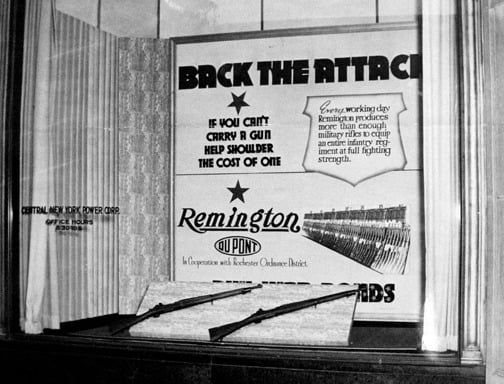 Patriotic store front in downtown Ilion during World War II. |
Questions in the Pursuit of Answers…
While we now know of the
return journey back “across the
pond” to the States, this author is
often asked about the initial
journey of the Remington rifles to
the UK in the first place. Unfortunately,
there remain at this writing
many more questions than final or
definitive answers. As previously alluded to, the reasons are many, including an apparent vacuum of surviving factory and
archival documentation. Most assuredly, the quest for answers will continue long after these words are penned. Therefore,
some of which follows is quite factual while informed speculation must necessarily suffice for the remainder.
What do we know for certain? In brief summary, the Remington Arms Company (RA) by the end of October 1941 had
tested, shot, inspected and placed in their warehouse stores a total of 101 M1903 rifles ready for Ordnance final inspection.
They had finally entered full production, although the daily rate was still only about 250 rifles during this early stage of the
effort. The US Ordnance Inspector at the Ilion plant had alerted his superiors at the Rochester Ordnance District (ROD) of the
imminent readiness to begin the formal inspection and approval of the first 4 lots of rifles (500 rifles each) beginning the second
week of November. It finally got under way on November 14, 1941 per Specification AXS-619 initially adopted the previous
August. Coincidently, this first inspection was completed the day following the “day of infamy”…December 8, 1941; and by
December 10th all the bugs had been worked out of those rifles needing corrections (rejections). Ordnance formally approved the
first 1000 Remington M1903 rifles on December 20, 1941. By January 3rd, a total of 10,440 had passed Remington’s own inspection
with 3706 accepted by Ordnance. So, Remington was finally on its way!!
Now comes the hard part. According to “Statistics” published by the U.S. Army, a total of 64,003 Remington rifles were
shipped to the British Commonwealth under Lend-Lease, including its Dominions. However, no one knows for sure how
accurate this number really is. It is unknown, for example, just how many of the rifles failed to arrive at their destination and if
such non-delivery was included in the accounting. At this time during the War, “Sinkings, as yet unmatched by new construction,
had leaped upward with the United States into war”. The reign of terror inflicted by the dreaded German U-Boats
operating in the Atlantic was essentially going unchecked. Indeed, it was reported: “If sinkings continued at current rates,
American forces would eventually be immobilized in the Western Hemisphere”.
As Table 1 (on the following page) shows, by the end of the first eight months of manufacture, Remington had supplied
(shipped) under their Ordnance Department contract almost 102,000 rifles. Outside of some test rifles used as part of the first
formal Ordnance inspection and approval in November 1941; U.S. Archive records seem to show very little evidence of their
| Page 23 | 3rd Quarter 2007 |
Table 1.
World War II: Remington Arms Co. – Model 1903 Rifle
History of Manufacture, Inspection & Shipping
( First 9 months )
__________________________________________________________
| RA Tested & Approved | Ordnance Final | Remington / Ordnance | ||||||
| Pdg. Ord. Inspection | Inspection / Approval | Warehouse Shipping Statistics | ||||||
| Month/Yr. | Warehouse Inventory | RA Payment | Final Adj’d | Inv per | Ship per Ord. Apprd. shipmts | |||
| Ending | Actual | Cumulative | Request | Ord. Apprl. | RA Invoice | RA accounts | Actual | Cumula… |
| _______ | ________ | _________ | __________ | ___________ | __________ | ________ | _____ | ________ |
| 10/41 | 101 | 101 | 0 | 0 | 0 | 0 | 0 | 0 |
| 11/41 | 1,892 | 1,993 | 0 | 0 | 0 | 0 | 0 | 0 |
| 12/41 | 7,031 | 9,024 | 891 | 1,273*1 | 891 | 0 | 11*2 | 11 |
| 1/42 | 11,048 | 20,072 | 16,445 | 16,063 | 12,826 | 4,510 | 4,510 | 4,521 |
| 2/42 | 15,158 | 35,230 | 11,981 | 11,981 | 10,806 | 14,001*3 | 14,000 | 18,521 |
| 3/42 | 19,240 | 54,470 | 21,889 | 21,889 | 8,704 | 23,991 | 23,991 | 42,512 |
| 4/42 | 24,189 | 78,659 | 25,982 | 25,982 | 3,346 | 31,340 | 33,341*4 | 75,853 |
| 5/42 | 30,479 | 109,138 | 28,691 | 29,470*5 | 4,244 | 27,793 | 25,792 | 101,645 |
| 6/42 | 30,351 | 139,489 | 32,941 | 32,162 | 2,181 | 35,004*6 | 34,994 | 136,639 |
NOTES:
1. Ordnance Final Inspection approved 382 additional rifles after close of Remington (RA) December 1941 billing
period; therefore, formally included in the RA January 1942 invoice.
2. 10 rifles sent to the Springfield Armory (SA) for gauging and drawing update on November 21, 1941 plus 1 rifle gifted
to Col. Roy L. Bowlin on December 10, 1941 were counted as shipped by Ordnance, but not yet reconciled in RA
payment records. ( Note: Col. Roy L. Bowlin was Deputy Chief of the Rochester Ordnance District (ROD). As
ranking military officer at the time, he was also Chief Inspector. Chief of the District up until July 1942 was Mr. Erwin
R. Davenport, a civilian.)
3. Remington credited itself in the February 1942 shipment accounting for the December 10, 1941 rifle gift to Col. Roy L.
Bowlin,
4. 4 additional lots of 500 rifles (plus one rifle) were released for shipping after RA completed its monthly accounting
for April 1942. RA credited itself the following month (May 1942).
5. Ordnance Final Inspection approved 779 additional rifles after close of the RA May 1942 billing period; therefore,
formally included in the June 1942 invoice.
6. RA credited itself in the June 1942 shipment accounting for the December 22, 1941 Ordnance request for SA return
of 10 rifles sent them November 21, 1941 for gauging and drawing update.
disposition after that. Fortunately, it is a known fact the initial shipment(s) were destined for the United Kingdom, which likely
explains their absence from US archival records. Coincidently, ongoing review of extant Remington serial numbers, research of
National Archive records and the writings of post War Army researchers, seems to indicate that by the end of April 1942 the bulk
of all such rifles shipped to the UK under Lend-Lease had essentially been terminated. Furthermore, it is also known that a
number of these rifles were redirected elsewhere, including US Troops then mobilizing for assignments in the South Pacific. So,
the question that remains unanswered is exactly where within the “Kingdom” did most of these Lend-Lease rifles actually end
up as well as how many went to US Forces within the first months of 1942?
| Page 24 | 3rd Quarter 2007 |
Up until the Japanese attacked the U.S. at Pearl Harbor and the Nation finding itself suddenly embroiled in World War II, all
of the first Remington M1903 rifles were unquestionably destined for the British homeland per historical fact. Remington had
been working feverishly to send out the first 10,000 rifles on or by January 1, 1942. At the time, they were still operating under
the auspices of their original contract agreement with the British Purchasing Commission before the US actually executed its
take-over contract. As it turned out, this schedule objective was never achieved. Indeed, as the following makes clear, the
subsequent goal to accomplish the same feat by February 1st didn’t happen either. Among other complications, RA was having
delay problems with Ordnance Supply finding enough accessory parts, including oilers, sight covers, bayonets and M1923
slings to go with the shipment.
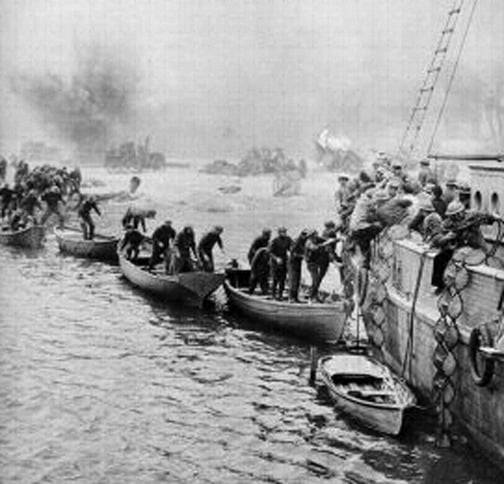 British forces were evacuated from Dunkirk between May 26th and June 4th, 1940. |
Remington finally announced on December 16th that “One of first orders sent out by the War and Navy |
Not only were the now dramatic increased needs of
our own troops suddenly paramount, the theater of war
boundaries had suddenly become worldwide. On January
12th, the War Department announced complete reorganization
of their entire war material planning and disbursement
program under Lend-Lease, which subsequently
was changed and/or adjusted many times, thereafter. In
cooperation with the United Kingdom (UK) authority in
Washington, it was immediately decided in strategic talks
that the first Remington rifles were more needed in the
South Pacific where the Japanese threat was considered
imminent. This included arming our own troops soon to
be deployed in the region.
Britain’s long held concern of a land invasion had greatly dissipated after Germany’s siege of Russia. Also, the UK was now
about to receive their beloved .303 Cal. Enfield in greater quantity from two North American continent contractors furiously
engaged in that effort. The latter rifles were destined for both regular troops and replenishment in the Middle and Far East as
well as the North African campaigns. Lastly, the first of the U..S. troops were about to land in Ireland to relieve British regulars
to other War sectors. So, the English were feeling much better about their home defense situation. But, with the Japanese
juggernaut now moving ever closer, the UK’s South Pacific Dominions were perceived to be under grave threat. They were
largely without sufficient small arms along with minimal manufacturing capability. So, to make a long story short, under a newly
launched Allied zone and command structure that was to include reassignment of General MacArthur from the imperiled Philippine
Islands, the destination of the first Remington ’03 rifles were redirected from the English mainland to the South Pacific
instead.
Midst extraordinary chaos, mis-communication and understandably poorly coordinated decisions, fully laden shipping
transport lying in New York harbor suddenly had to be off-loaded and arrangements made for land transport to the West coast in
both competition and coordination with other critically needed priorities in the South Pacific. While it was an average 17-day
sea journey for shipping bound for Liverpool from New York, it was oft times in excess of 24 days to Auckland, New Zealand
from the San Francisco Port of Embarkation. This was further compounded by the sudden enormous demand for rail scheduling
as well as the longer distance to the West coast from New York. So, substantial delays were inevitable even for East coast
shipping sent through the Panama Canal.
As Table 1 reveals, only 4,521 approved rifles had actually departed Remington’s Ilion, NY plant by the end of January 1942.
It is not known at this time whether the additional 14,000 rifles (…or part thereof released from stores by the end of February)
| Page 25 | 3rd Quarter 2007 |
|
ever joined the initial lot on the same freightertransport convoy bound for Auckland or not. The likelihood is they did not since the Archives of New Zealand reports that by “…the end of January the first American supplies… including 3,900 rifles…” arrived to supplement the critical defense of New Zealand’s Fiji Island Garrison. From this number “…two thousand of the rifles…were sent on to New Zealand”. All of these rifles are believed to be a |
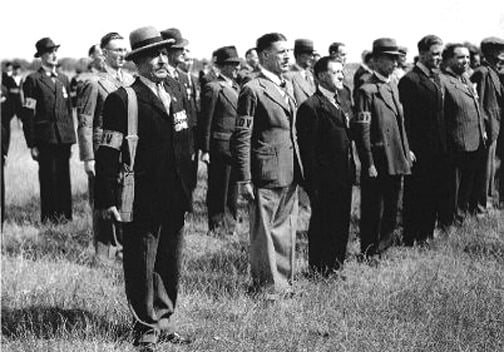
|
portion of the initial Remington
‘03s bound for England. The record goes on to
report that by 7 April 1942, the New Zealand
military had received 12,000 such US made
“.300 calibre rifles”; and by the end of April
1942, “…24,500 American .300 rifles had
arrived…” in New Zealand and assigned
various Home Guard defenses in “…the more
remote districts…” such as “…Southland,
Nelson, Coromandel and Hawkes’s Bay…”. It
is presumed all were the Remington made
M1903 since it is also known that arrival of
these American rifles enabled the precious few
.303 Cal. Enfield rifles in New Zealand’s possession to be redistributed to other Home Guard and “Territorial Units” operating
closer to mobilized regular troop centers.
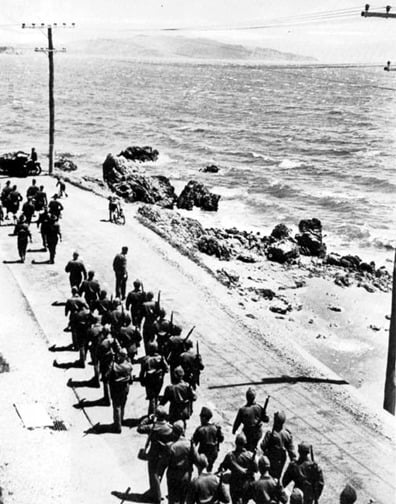 New Zealand Home Guard on the march – 1943. |
Nevertheless, the British War Department still considered the Remington M1903s important for critical home defense of the English mainland as soon as they could be made available. Their Home Guard along with critical port and airfield defenses had never been fully or adequately armed. Most of the new Enfield production emerging from North America was destined to replenish Army regulars on the battlefields of North Africa and beyond. It is believed, therefore, that many of the subsequent Remington ’03 shipments from the end of February through April 1942 were shared between the UK Dominions in the South Pacific and the original English homeland destination. This conclusion tends to also make sense based on the serial number (SN) evidence of the “Red Star“ rifles thus far uncrated. A preponderance appears somewhere in the range |
between SN 3,020,000
and 3,055,000 even though higher and lower numbers are
documented. Even their stable-mates independently
imported to the States in the mid-1950s by commercial
arms importers, and bearing all proper British export
markings, appear in this proximate January-March, 1942
serial number range.
It remains unknown just how many of the foregoing
rifles actually arrived at the UK homeland and South
Pacific Islands as well as make the return trip back to the
USA. It is believed with some certainty that many remain
eternally at the bottom of the Atlantic and South Pacific
…never having arrived at their destination as well as
meeting a similar fate after the war was over. Indeed, the
enormity of the excess armament inventory after the War
was such that a “dumping” solution became a logical “…disposal expediency versus inventory management.” Unfortunately,
we’ll likely never know for sure how many Remington M1903 rifles now adorn Neptune’s deep, including which serial numbers
In the early months of the war, members of the British Home Guard
(LDV) were in dire need of military weapons of any kind.
| Page 26 | 3rd Quarter 2007 |
(SN). Speculative conclusions to date are predicated on which SN ranges turn up proportionally fewer examples …and which
seems to strongly point to survival of less than one-half of actual manufacture shipped the UK and its Dominions.
In conclusion, it is not the purpose of this article to comprehensively deal with the WWII journey of early Remington Lend-
Lease rifles, including their ultimate fate. While much is being learned…even as this article goes to print, there is much yet to
be uncovered, including how many thousands of these rifles were broken down into parts, or just how or why “…American
rifles of which 40,000 now had been imported ” ended up in New Zealand by October 1942!
Note: Another report from the Quartermaster General’s Branch states that 42,428 had arrived by 31 March 1944.
Suffice it to say, the truth may very well be the British Dominion of New Zealand received more of the Remington ’03 rifles
than did the British homeland. Someday we may know for sure. Nonetheless, it remains another pursuit for another time since
the primary WWII duty of the “Red Star” rifles can be specifically traced to the English mainland.
The “Red Star” Rifles: Disinterment
Many have wondered over the years what it must have been like to witness opening the lid of a crate full of old rifles
imprisoned for a half-century. This will hopefully be further elaborated on in the last and final Part III – conclusion, but suffice
for now to hear it second hand from one who was there in 1997-98.
|
Ian Shein, Former Employee Red Star Military Museum and Sales Culver City, California |
As the rifles were offered for sale, “Red Star” personnel didn’t bother to thoroughly clean them nor give the buyer much
option as to what was purchased. They were sold as is… with many acquired sight unseen by out of state collectors. The fact is
most buyers really didn’t care since they were assured of receiving a true collectors piece that had been fired very little, if at all,
remaining essentially in the same condition-state as when released from the Remington factory 55 years previous.
The Beauty and the Grease
|
These pictures are intended to provide both a close up viewing of what a typical “Red Star” looks like upon extrication from its wooden prison as well as greater detail of British Ordnance markings. The multiple photos following consist of images of sn 3032088 cleaned only enough to reveal such detail. The black numerals 30 or 300 within the red painted band do not always line up, thus indicating some of the rifles no longer contain their |
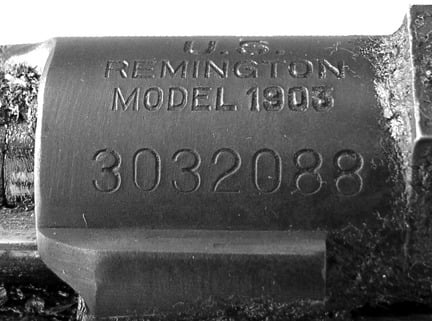
|
original issued hand guard as first painted during Ordnance preparation for
distribution. Based on this author’s investigation since 1998-99 … with
very few exceptions, that is the way the rifles were returned to the States,
including delivery to the “Red Star” store in Culver City, California. The
crates were previously unopened. Therefore, it is concluded the mismatch
likely occurred at the time the rifles were prepared by the MOS for re-crating
in England in the 1950s.
The insufficiency of space precludes any sort of comprehensive technical treatise regarding sn 3032088 beyond what was
revealed in the 1999 article. That will have to wait another time. Nevertheless, the rifle seems to affirm much of the parenting
already concluded about Remington’s early manufacture. Some further observations follow. An inner configuration autopsy
has not yet been conducted since the owner chooses to keep it unaltered.
| Page 27 | 3rd Quarter 2007 |
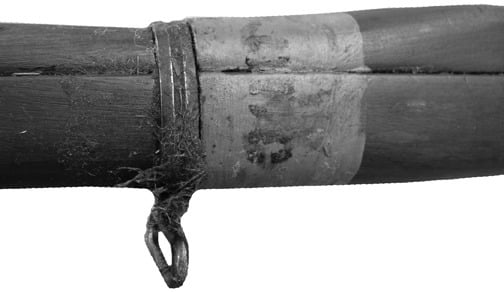
As witnessed many times, the hand guards of these rifles were
cracked along with evidence of other wood dents and abrasions. Basically,
this was a direct result of the aforementioned inadequate packing
system during the journey to and from England. Also noted is the extreme
dryness of the wood. In the over 50 years since these rifles have been
handled, they are in dour need of replenishment of lost wood oil. Sn 3032088
has not escaped such distress.
Another observation made from some of the photos is the extraordinarily beautiful contrast between the bright blue screw
and bolt-heads against the original gray-black Parkerizing (with olive-green tint in daylight). Also, the fine smooth finish of the
bolts of the very early rifles is noted. Many reveal their original bright blue factory color in use prior to approval of the later
black oxide finish. Lastly, sn 3032088 is somewhat unique inasmuch as it is
composed of the earlier scalloped (lightening
cut flutes) rear sight Fixed Base along
with a receiver not
having its rear tang
drilled all the way
through for the rear
stock bolt. This
|
author has discovered on numerous occasions that when this latter combination is present…even on later serial numbered rifles, the barrel date will likely be no later than 1 – 42, with a better than average probability the boltbody |

|
contains a
small gas hole (3/32
inch diameter).
Surprise! While the
barrel date is 1 – 42
on this particular
rifle, the bolt-body
gas hole is the
second-generation
The red painted band denoted a
caliber other than the standard
.303 British cartridge.
“Red Star” Remington Model 1903
rifle sn 3032088 was, like the
others, packed in grease and
straw for many decades.
| Page 28 | 3rd Quarter 2007 |
enlarged variety (11/64 inch diameter),
but retains the bolt stop
detents on the left rail lug. So much
for allusive predictability theories…!
Remington Sub-Inspector
and British Ordnance
Stamps
The accompanying images that
clearly reveal a variety of both
factory sub-inspector stamps and
British markings placed on the underside of the stock just in front of the trigger guard. Each odd-looking Remington symbol was
assigned a different inspector charged with a different piecework inspection task. These symbols originated from the Standard
Code of Inspection Designs, which RA used until June 1942 before changing over to a more conventional geometric shape
containing a number or letter pursuant to the then forthcoming M1903A3 program.
(Note: This author sometimes refers to these particular markings as “Remoglyphics”)
Unfortunately, when the Lend-Lease rifles arrived in England, British Ordnance authorities decided to also use the same
general location on the underside of the stock to stamp their own inspection/ownership/acceptance markings. As some of the
photos clearly show, they were rather indiscriminately placed, often obliterating the Remington factory markings.
As of this writing, the author has been unable to decipher or explain the exact significance of the British markings
except to note:
2. WWII British historians engaged by the author were somewhat bemused themselves by the practice. Indeed many are of the opinion such markings, including armorer, depot, unit or issue stamps were reserved only for domestic production …if used at all; and
3. the various markings did not all originate at the same location, by the same inspector, at the same time or for the same purpose.
|
The six rifles in the photos were especially selected to |
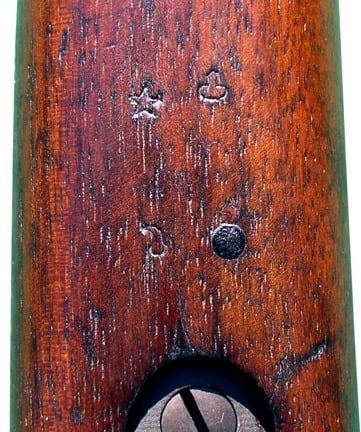
|
Photo No.2 and No.4 reveal an example of the use of two
individual numeric hand stamps, i.e. “4 & 3”, and “4 & 0”,
respectively. The rifle in Photo No. 3 reveals a similar pattern,
however, it was handled at least twice, i.e. its numeric “4 & 3” also
carry standard British “cancellation stamps” striking through the
two numbers, thus indicating the original purpose of the stamp(s)
were officially negated. Photo No.5 and No.6 are the most prolific
examples of markings in the area of the Remington inspection
stamps inasmuch as they also carry additional stamps such as
“W/4”, “W/7” and a “J”. Of the latter two, the rifle in
Photo No.6 reveals it’s “4 & 3” as also having been “cancelled”.
| Page 29 | 3rd Quarter 2007 |

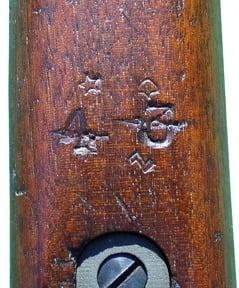
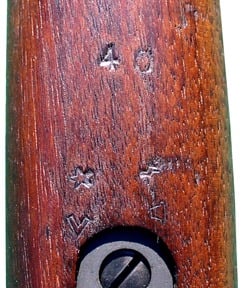
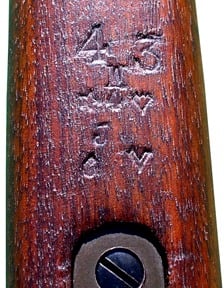
| Page 30 | 3rd Quarter 2007 |
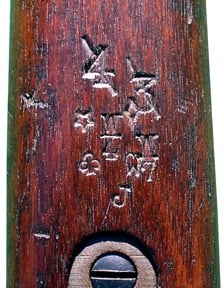
| Page 31 | 3rd Quarter 2007 |
In closing, it is noted that British historians engaged by this scribe are of the opinion the W related markings likely
indicate exit processing through the Central Ordnance Depot at Weedon. The overall inconsistency of marking protocol is likely
explained by simple lack of established uniformity, i.e. the fact that “So great was the influx of weapons and stores at this
period that Sub Depots or Relief Depots”… were necessarily opened at six other locations. For example, in 1940, Sub-Depots
were opened at Long Buckby Brickyard and Heyford Brickyard. In 1942, two more were opened elsewhere and yet two others in
1943. “These Relief Depots were concerned with receipt and storage of weapons, etc.” In addition to these six…”During
1942, Old Dalby became a shadow Depot of Weedon …”. Weedon and Old Dalby alone issued over 3.5 million weapons by
November 1943.
Epilog
Remington M1903 collectors everywhere should be eternally grateful to Lt. Col. Willard Levin. His life was worthy …if for
no more than his war record, let alone his legacy-gift of the “Red Star” Remington rifles to posterity. Today, there remain at
least 5 unopened crates now over 52 years old since arriving back in the U.S. No one knows for sure what lies buried within
except for the presence of M1903 rifles and a lot of Anglican straw-like packing material and grease. From previous unveilings,
there is a distinct possibility that other vintage ’03s may be present. Thus far a M1903A3 has been found. Even an RIA stocked
(ELJ cartouche) Springfield Armory edition with a 1-19 barrel (sn 221265) was discovered. How the non-Remington rifles got
mixed in is anyone’s guess. But, if the random nature of opening previous crates is any indication, most all the rifles are likely
Remington made and in excellent overall condition, with the vast majority in the 3,020,000 to 3,055,000 serial number range. The
rifles now wait a proper time to be carefully and properly documented for research and study. Meanwhile, we continue to learn
from the ones already having seen the light of a new day.
Bibliography, Sources
• Record Group 156: miscellaneous files and documents, Chief of Ordnance, 1940-45; National Archives and Records
Admin. (NARA)
• Clark S. Campbell Collection; original letters, memos, drawings & documents from Plant Manager files, Remington Arms
Co., Inc.; Ilion, NY; 1955
• Personal Interview and Discussions; Ian Shein, former employee of Red Star Military Museum and Sales; 1998-2007
• Personal Conversations & Correspondence Records; surviving family members of Willard Levin, 2003-2007
• Department of Health, Vital Records, State of Ohio; Columbus, Ohio
• Los Angeles Times – Obituaries / July 16, 2006; Los Angeles, CA.
• Air Force Institute of Technology, Public Affairs Office; Wright-Patterson AFB, Ohio
• Handbook of Texas, Texas historical Assoc., University of Texas at Austin
• Report to the Community – 2002-2003, Victoria College; Victoria, Texas
• Military Personnel Records, National Personnel Records Center; St. Louis, MO
• Internet Sites:
Wikipedia.org (various military history websites)
B24.Net/392nd
2ndair.org.uk
• The Broad Arrow: British and Empire Factory Production, Proof, Inspection, Armourers, Unit & Issue Markings, by Ian
D. Skennerton; 2001
• The Lee-Enfield Story by Ian Skennerton; 1993
• “Deadly Business” by Patrick Brogan and Albert Zarca; W.W. Norton & Co.; 1983
• “Roosevelt and Hopkins” by Robert E. Sherwood; Harper & Brothers; 1948
• “The Hinge of Fate” by Winston S. Chruchill; Houghton Mifflin Co.; 1950
• “Strategic Planning for Coalition Warfare” 1941-42 by Maurice Matloff & Edwin M. Snell; Office of the Chief of Military
History, Dept. of Army; 1953
• “The Ordnance Dept: On Beachhead and Battlefront” by Lida Mayo; Office of the Chief of Military History, Dept. of
Army; 1968
• “The Ordnance Dept: Procurement and Supply” by Harry C. Thomson and Lida Mayo; Office of the Chief of Military
History, Dept. of Army; 1960
• “The Ordnance Dept: Planning Munitions for War” by C.M. Green, H.C. Thomson & Peter C. Roots; Office of the Chief
of Military History, Dept. of Army; 1955
| Page 32 | 3rd Quarter 2007 |
History, Dept. of Army; 1995
• “The United States Army in World War II – Statistics (Lend-Lease)” by Theodore E. Whiting, Carrel I. Tod & Anne P.
Craft; 1952
• “The Big L – American Logistics in WWII” by Alan Gropman; National Defense Univ. Press; 1997
• “Logistics in WW II , a Final report of the Army Service Forces”; Center of Military History; 1993
• “American Military History 1607 – 1953”; Dept of the Army, July 1956
• “Lend-Lease: Weapon For Victory” by Edward R. Stettinius Jr.; McMillan Co.; 1944
• “The Industry-Ordnance Team” by Lt. Gen. Levin H. Campbell; Whittlesey House; 1946
• “History of USMC Operations in WWII, Vol. 1: Pearl Harbor to Guadalcanal” by Hough, Ludwig & Shaw; Historical
Branch, Hdqtrs., USMC
• “Studies of Overseas Supply” by H. Duncan Hall & G.C. Wrigley; H. M. Stationery Office and Longmans, Green & Co.;
1956
• “North American Supply” by H. Duncan Hall; H.M. Stationery Office and Kraus Int’l Publications: 1955
• “Britain’s Home Guard” by John Brophy & Eric Kennington; George G. Harrap & Co.; 1945
• “The Home Guard of Britain” by Charles Graves; Hutchinson & Co.; 1943
• “Dad’s Army – The Home Guard, 1940 – 1944″ by David Carroll; Sutton Publishing; 2002
• “The Real Dad’s Army” by Norman Longmate; Arrow Books; 1974
• “The Liberators From Wendling” by Robert E. Vickers Jr.; Unit Memorial Collection; 1977
• The National Archives of the United Kingdom (PRO), general reference information; Kew, Richmond, Surrey, England
• Imperial War Museum; general reference information; United Kingdom
• Ministry of Defence- Royal Armouries Museum (SATC); Leeds, England
• MOD Pattern Room – Royal Small Arms Factory; general information; Nottingham, England
• “A History of Proof Marks – Gun Proof in England” by Lee Kennett; Gun Digest – 31st Edition.; 1977
• The Gun Barrel Proof House, general reference information; Birmingham, England
• “A Short History of the Technical Stores Depot, Weedon 1804-1965” by J.E. King; 1965
• 2nd Air Division Memorial Library; general reference information; Norwich, England
• “The Home Front” by Nancy M. Taylor; Historical Publications Branch, Dept. of Internal Affairs; Wellington, NZ; 1986
• “The Pacific” by Lt. Col. Oliver A. Gillespie; Historical Publications Branch, Dept. of Internal Affairs; Wellington, NZ;
1952
• Archives – New Zealand; general reference information; Wellington, NZ
• New Zealand Defence Library; general reference information; Wellington, NZ
• Kippenberger Military Archives and Research Library Army Museum; general reference information; Auckland, NZ
• Auckland War memorial Museum, Information Centre; general reference information; Auckland, NZ
The author would like to thank many librarians, archivists and others for their assistance, particularly those individuals
thousands of miles away who patiently put up with a constant barrage of inquiries. Some eventually grew weary, but many
managed to persist. Some of the latter who come to mind are: Robert A. Sharrock at the Ministry of Defence in England; David J.
Penn of the Imperial War Museum in England; Lesley Fleetwood at The Memorial Trust of The 2nd Air Division, USAAF; and
Heidi Kuglin of the Archives-New Zealand.
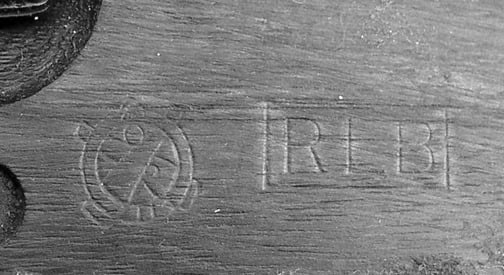
Stock stamping on “Red Star” Remington Model 1903 “Modified” – sn 3032088.
| Page 33 | 3rd Quarter 2007 |
| On-line Search/Sort Journal Index |
On-line Journal Articles New Journals have links to
|
